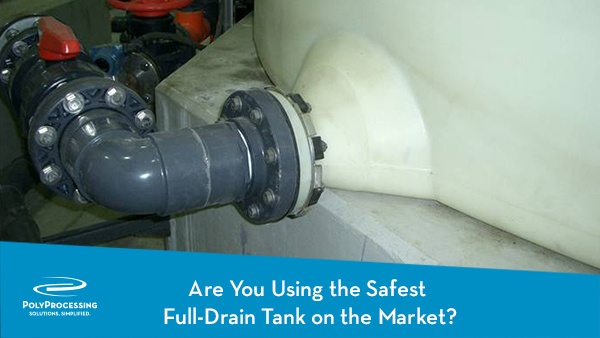Are You Using the Safest Full-Drain Tank on the Market?
Properly storing chemicals also means completely draining your storage tanks. Your regular maintenance and cleaning routine must include fully draining your chemical tanks to prevent contaminating new batches.

But sometimes, draining the tank is easier said than done. Space constraints, incorrect fitting placements, and dealing with hazardous chemicals can all complicate routine maintenance.
These challenges can make it tempting to put off regular tank draining and maintenance—a dangerous option that could harm your chemicals, your equipment, and your employees.
A better option is full-tank drainage. Full-tank drainage makes it easier to clean and maintain your chemical storage system in the following ways:
-
Minimizing residual chemicals. Full-drain tanks help eliminate remnants of older chemicals that are left behind. Residual chemicals can compromise the quality of the new batch of chemicals.
-
Easier and safer tank cleaning. A proper full-drain system means plant employees don’t need to enter a tank and risk contact with hazardous chemicals in the confined space.
-
Eliminating free radicals. When certain chemicals are stored over time, salts and metals fall out of the chemical and collect at the bottom of the tank. If you don’t have full-tank drainage, new chemicals that are placed in your tank will mix with the salts and heavy metals and create free radicals. These free radicals attack the interior surface of the tank, which can cause damage and compromise the integrity of your chemical storage system.
-
Preserving structural integrity. With full-drain systems, you don’t need to drill holes in the tank to add side-manways or fittings. Drilling holes creates an opportunity for structural damage, and potential for deterioration of gaskets and fittings.
Not All Full-Drains Are Created Equal
To construct a full-drain system, some companies manufacture tanks out of one substance and insert a fitting in the mold or install a fitting after production. It’s a common and much less expensive solution in the chemical tank industry, but this method creates new problems, including compromised structural integrity and tank maintenance issues.
Compromised Structural Integrity
An insert, whether it is molded in or installed post-production, can impact the tank’s hoop integrity. This puts the entire tank at risk of structural stress from volatile chemicals. Inserts are metallic and don’t have the same chemical resistance as the tank itself. So chemical reactions where the tank meets the metal can create a stress point for the plastic itself. Before long, it can create leaks or cracks in the tank wall.
Tank Maintenance and Draining Issues

Inserts need to be installed one to two inches above the knuckle radius of the tank. That one to two inches makes a big difference, because that means you’ve got an inch or two of chemical and or sediment left in the tank. Your full-drain system isn’t actually full-drain, and it still requires manual clean out—a dangerous and time-consuming process.
A Better Full-Drain Solution
Poly Processing offers a better full-drain solution that eliminates many of the problems that other full-drain systems don’t fix. With our innovative Integrally Molded Flanged Outlet® (IMFO®) system, the flange is molded into the tank during manufacturing, rather than being introduced post-production as an insert. IMFO-style fittings are made from the same material as the tank, creating a one-piece, homogeneous unit. Because the IMFO fitting is part of the tank itself, there is no added stress on the lower sidewall.
The one-piece construction also enables the flange to be placed at the very bottom of the tank’s sidewall, below the knuckle radius—not two inches above it. IMFO tanks are the only full-drain polyethylene tank to provide a true full drain of your stored chemicals.
Any required maintenance is simple and hassle-free, as the flange extends away from the tank wall. The entire flange system is external to the tank, with easy hardware access from outside the tank—unlike metallic inserts.
Sloped-bottom IMFO for Heavier Chemicals and Substances

Poly Processing also has a sloped-bottom version of the IMFO tank, which we recommend for heavier materials such as FOG (fat, oils, and grease) or sludge. The additional gravity feed allows for these heavier substances to drain more easily. Cleaning is even simpler, because there is no need for a confined-space entry. Instead, the sloped-bottom tank can be cleaned from the top from the manway, or with a spray ball installed in the dome, which is much safer for personnel.
Second, the sloped IMFO allows the heavier materials and chemicals to evacuate during draining so there is no sediment or sludge that builds up.
Get the Full-Drain System You Need
If you need a full-drain tank, make sure you’re truly getting 100 percent full-drain. And make sure you purchase a tank that can give you the structural integrity you need.
Learn more about full-drain systems—
- June 20, 2018
- Topics: Tank Design and Materials
About Poly Processing
Posts By Topic
Tech Talk Podcast Episodes
Subscribe By Email
Recent Posts
- Installation Tips for Chemical Storage Tanks: Site Preparation and Offloading
- Understanding pH and Chemical Concentration When Choosing a Chemical Tank
- Maximizing Fill Efficiency: Selecting the Optimal Fill Line System
- Chemical Storage Tanks: A Quick Guide for End Users
- Popular Customization Options for Chemical Storage Tanks
Tank Configurator

Find the recommended tank and system components for your chemical storage challenge.
Configure a Tank Package


